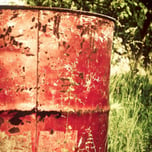- GreenMatch
- Blog
- Are Diamonds Bad For The Environment?
Are Diamonds Bad For The Environment? Statistics, Trends, Facts & Quotes

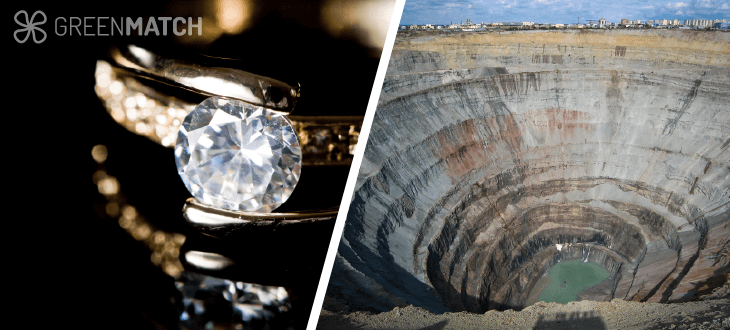
Diamonds have long been revered as symbols of love, luxury, and timeless elegance. Beneath their sparkling façade, however, there is a controversial debate over their environmental impact.
Mining for diamonds can result in the destruction of land and the release of harmful chemicals. It's estimated that for every carat of diamond mined via traditional methods, nearly 100 square feet of land is disturbed, and more than 5798 pounds of mineral waste is created.
However, current estimates predict that by 2050, demand for diamonds will be as high as 292 million carats (that's nearly 60 tonnes!) - and with a global market worth over £68.5 billion, it's clear that diamonds are as popular as ever.
But what does this intense demand mean for the future of our planet? Is there an alternative to harmful mining methods through 'lab-grown' diamonds? Or are we too blinded by the sparkle to see the damage this industry is doing?
In this article, we delve into the heart of the matter and uncover the truth about diamond mining, discover the facts and statistics, and learn whether these precious gems are worth such a long-lasting cost.
- What do we mean by diamond mining exactly?
- Environmental impact of diamonds
- Social impact of diamond mining
- Economic impact
- What are diamond alternatives?
- Are diamonds sustainable?
- Is diamond production toxic?
- Can you recycle diamonds?
- Are diamonds biodegradable?
- Statistics, facts and figures about diamonds
- Frequently asked questions
What do we mean by diamond mining exactly?
Diamonds are natural minerals, composed of carbon atoms bonded in a specific crystal structure. They are formed deep within the Earth, approximately 90 to 125 miles below the surface, under high temperature and pressure conditions.
The formation of diamonds is a complex process that can take billions of years. Diamond mining is most commonly found in countries including Botswana, Canada, Namibia, Russia, South Africa, Australia, and Tanzania - as these locations are rich in diamond deposits.
To retrieve them, they must be mined, which can be done via methods including open-pit mining, underground mining and marine (or 'alluvial') mining - from riverbeds or undersea locations.
The most common type of diamond mining is open-pit mining, which involves the removal of layers of sand and rock to reach 'kimberlite' deposits - a type of volcanic rock which contains diamonds. Kimberlite occurs in the Earth's crust in vertical structures, known as kimberlite pipes, or in horizontal sills.
These vast pipeline deposits, once reached, are blasted with explosives or crushed to break them down. Smaller sections can then be crushed and processed to extract diamonds.
Kimberlites are the most important source of diamonds in the world. About 6,400 kimberlite pipes have been discovered in the world, of those about 900 have been classified as diamondiferous, and of those just over 30 have been economic enough to diamond mine.
These methods are incredibly effective, but as you can imagine, the entire process requires a large amount of energy and land area. The impact of this process, therefore, must be considered.
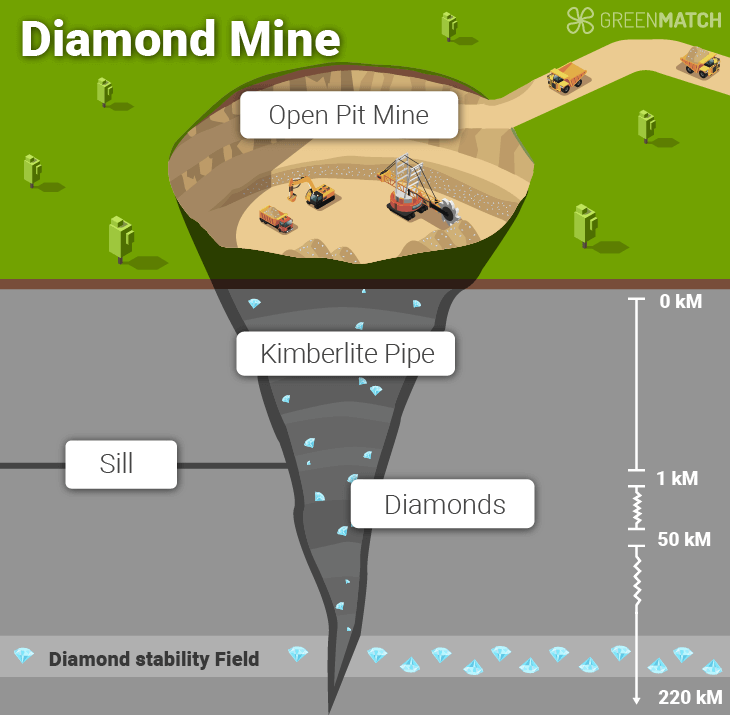
Environmental impact of diamonds
Diamond mining can significantly impact the environment, from the intital exploration phase to the extraction and processing phase. Some key environmental concerns associated with diamond mining include:
Deforestation and habitat destruction
Large areas of land are significantly altered to clear the way for mining. The infrastructure of mining sites can include the creation of access roads, water sources and waste piles - even before you consider the large quarries or open pits created throughout the mining process.
Diamond mines exist in a wide variety of ecosystems - the African Savannah, the Karoo Biome, the Namib Desert and the Benguela marine ecosystem in Namibia.
When a mining operation begins, if not carefully managed, it can lead to a massive loss of habitat and vegetation, crucial to local wildlife and surrounding communities. Some operations can also disrupt marine ecosystems, damage coral reefs, and disturb coastal habitats, impacting marine biodiversity and fisheries.
Pollution
Heavy machinery and equipment used in diamond mining can release pollutants into surrounding ecosystems. Water use for washing and processing extracted ore, for example, can result in water pollution.
Pollution in areas downstream from mines can be outright poisonous to animals or humans exposed to it. Even an increase of sediment can sufficiently change the water conditions that the minute water life is threatened, thus affecting the whole food chain.
Pollution, or destruction, of a species' habitat can devastate the entire ecosystem that relies on it. In addition, the destruction of land and increased noise and activity from humans and machinery can cause species to be displaced. The impact on wildlife from mining is so severe that nature reserves are being created to protect species which can no longer migrate through mining areas. In parts of South Africa and Sierra Leone, stagnant water at disused mines invites new, unwanted species, such as mosquitoes, which carry malaria - a life-threatening disease.
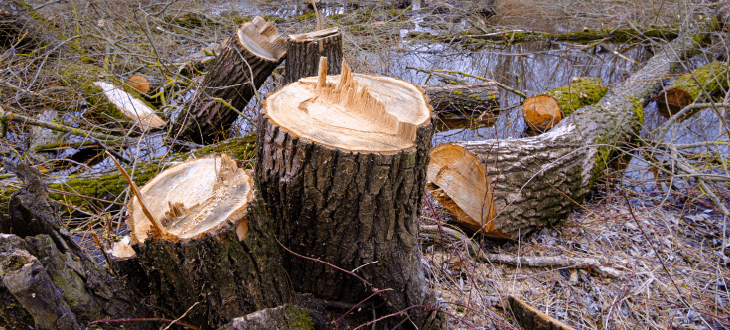
Soil erosion
The excavation and extraction processes involved in diamond mining can lead to soil erosion. This erosion results from removing vegetation and topsoil, leaving the land vulnerable to wind and water damage.
Soil deterioration and low water quality due to erosion and surface runoff [...] may become so severe that the land can no longer be cultivated and must be abandoned.
Soil erosion degrades agricultural land, diminishes soil fertility, and increases the risk of landslides and sedimentation in nearby waterways. This can also change the course of waterways, affecting land and water environments.
CO2 emissions
Another concern is the energy use level and carbon emissions associated with the heavy machinery and processing in a mining operation. These emissions contribute to greenhouse gases within our atmosphere and are directly linked to climate change and global warming.
Industrial activity (including the production and use of electricity) creates emissions – greenhouse gases – and other chemical (synthetic and natural) substances. These are released into the air and cause a range of environmental problems, from climate change to smog, which threatens our health and our environment.
According to one diamond mine's data, they produced 727 pounds of carbon dioxide emissions per carat mined in 2022, totalling 164,900 metric tons of CO2 annually. Although this is just one example, it indicates the high level of emissions being produced globally.
The carbon footprint of diamonds is significant. Research undertaken for Imperial College London in 2021 looked closely at the typical emission levels and other environmental impacts of mined diamonds. From these results, we found the following.
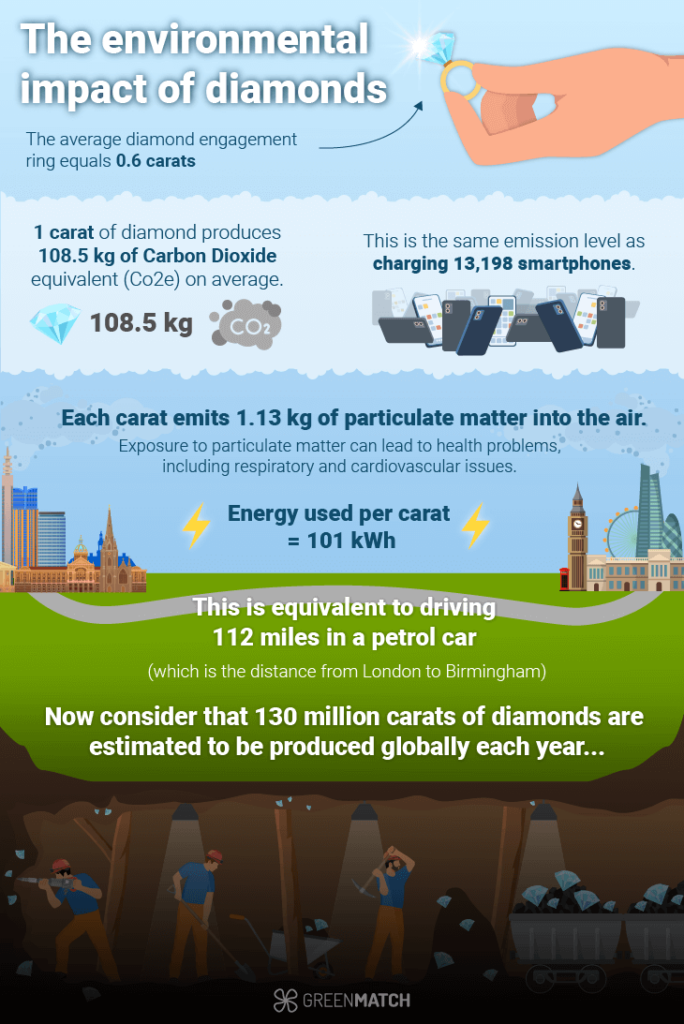
Social impact of diamond mining
In 1947, Frances Gerety coined the phrase 'A Diamond is Forever' for the jeweller De Beers. This became one of the most famous slogans in advertising history and was widely attributed to creating a surge in demand for diamond jewellery (particularly as a romantic gift).
Over 70 years later, however, this demand's true impact is being felt globally. Diamond mining has an adverse effect, not only on the natural world around us, but also on the communities living in mining countries.
Conflict diamonds (blood diamonds)
Since the early 2000s, diamond mining has been closely connected to civil wars, particularly in parts of western and central Africa. The phrase 'blood' diamonds or 'conflict diamonds' arose. The United Nations (UN) defined blood diamonds as:
Any diamond that is mined in areas controlled by forces opposed to the legitimate, internationally recognised government of a country and that is sold to fund military action against that government.
In regions where conflict diamonds are prevalent, local communities endure immense suffering. Forced labour, exploitation, and human rights violations are widespread, with workers subjected to hazardous conditions and meagre wages. The presence of armed groups further compounds the social impact, as they exploit the diamond trade to fund their activities, perpetuating violence and instability.
The Kimberley Process
The international community established the Kimberley Process in 2003 in response to the ongoing challenges. The aim is 'to prevent the flow of conflict diamonds while helping to protect legitimate trade in rough diamonds' (Kimberley Process).
By implementing strict certification and tracking mechanisms, the Kimberley Process seeks to promote ethical diamond sourcing and provide consumers with assurances regarding the origins of their diamonds.
However, the scheme's effectiveness has been scrutinised, with concerns raised about its ability to effectively address the complexities of conflict diamonds, particularly in the face of evolving trade dynamics and loopholes within the certification process. There is also very little in the way of tracking for concerned consumers at present.
Consumers who care can trace the fish on their plate back to the patch of sea it was taken from. They can choose fair-trade apparel that benefits the cotton farmers and seamstresses who produced their clothing. But the lineage of one of the most valuable products that many consumers will ever buy in their lifetime remains shrouded in uncertainty
The ethical dimensions of diamond sourcing and trade remain a focal point of discussion within the industry, with calls for greater transparency, accountability, and ethical practices.
Economic impact
The diamond industry plays a significant role in the economies of many countries. Diamonds contribute to employment, foreign exchange earnings, infrastructure and social development investment.
In mining countries, diamond operations provide employment opportunities, often serving as a key source of livelihood for local communities. This can stimulate economic activity and contribute to poverty reduction, education, healthcare, and infrastructure development, fostering economic growth and social progress.
On a global scale, the diamond industry encompasses various activities, including cutting, polishing, jewellery manufacturing, and retail. This creates a complex network of economic interdependencies, supporting jobs and livelihoods across the globe.
It is important, however, to acknowledge that the economic impact of diamonds is not without its challenges. The industry has faced criticisms regarding revenue transparency, distribution of benefits, and the potential for economic dependence on diamond revenues in mining countries.
Diamonds in the largest economies
The top diamond-producing countries in the world include Russia, Botswana, Canada, Angola, and South Africa. In 2023, Russia was thought to have the largest diamond reserves in the world, with an estimated 600 million carats.
Almost half of all diamonds worldwide are used for industrial purposes, such as cutting, drilling, grinding, and polishing. The total global reserve of these diamonds is estimated at 1.7 billion carats.
Some of the largest economies are affected by the import and export of diamonds. Below are some key facts about these economies:
-
African Countries
The diamond trade contributes approximately $7.6 billion per year to Africa. For example, diamonds account for 71% of Botswana's export revenue, 16% of the government revenue, and 16% of the gross domestic product (GDP).
In Namibia, diamonds represent approximately 21% of GDP, 48% of export revenue, and 59% of the government's annual revenue. (Diamondfacts.org)
-
Russia and Botswana
Together, these two countries produce 43% of the total volume and 53% of the total value of rough diamonds globally.
-
South Africa
South Africa produces around 49% of the world's diamonds, and mining significantly impacts its economy. De Beers, which owns most of the mines in South Africa, controls about 80% of diamond sales, bringing significant money into the South African economy.
-
Canada and Australia
Canada is the world's third-largest producer of diamonds, while Australia is the world's fourth-largest producer.
Diamonds can shape and impact a country's operations, particularly for larger communities in mining areas. Economies can be greatly affected by the diamond industry.
Leading diamond-producing countries
According to the latest data, Russia, Botswana and the Democratic Republic of Congo are thought to hold the largest diamond reserves in the world - as demonstrated below. These figures are for industrial diamonds only.
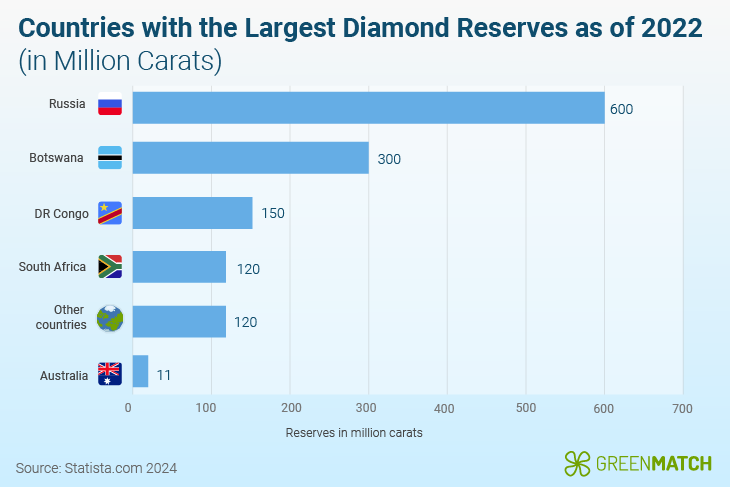
Rough diamond production, which leads to the sparkling gems we recognise in jewellery, also comes predominantly from Russia. They are the largest producer of rough diamonds, with approximately a 35% share in the total volume worldwide in 2022.
However, Botswana comes a close second in the production of rough diamonds and is thought to contribute the highest value diamonds to the global market. The global value of diamonds in 2022 was approximately £12.8 billion, with Botswana holding a 29% share.
Below is a demonstration of the rough diamond output per country, according to the latest data.
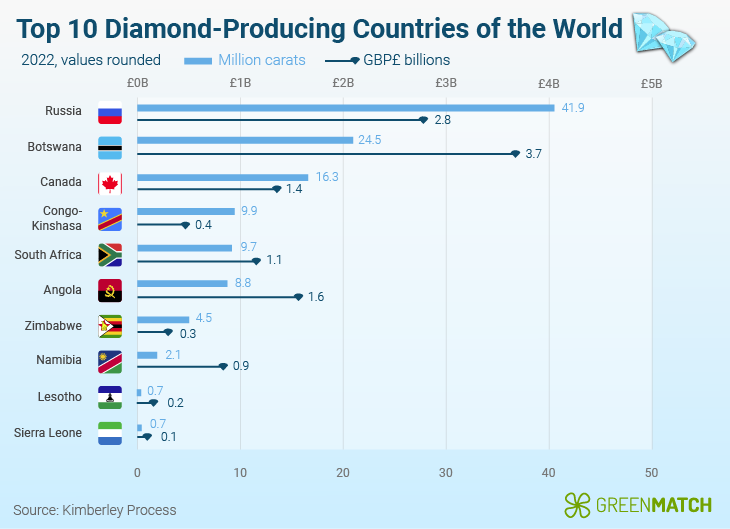
Of course, the majority of money in the diamond industry comes from those who purchase them - the importers and the consumers.
Import and export of diamonds
The largest importers of diamonds are India, the United States, and Hong Kong. Latest figures from 2022 estimate that India imported diamonds worth £21.5 billion, while the United States imported £18.6 billion.
Below is a map of the largest importing countries based on the latest data and estimated value of the diamonds imported.
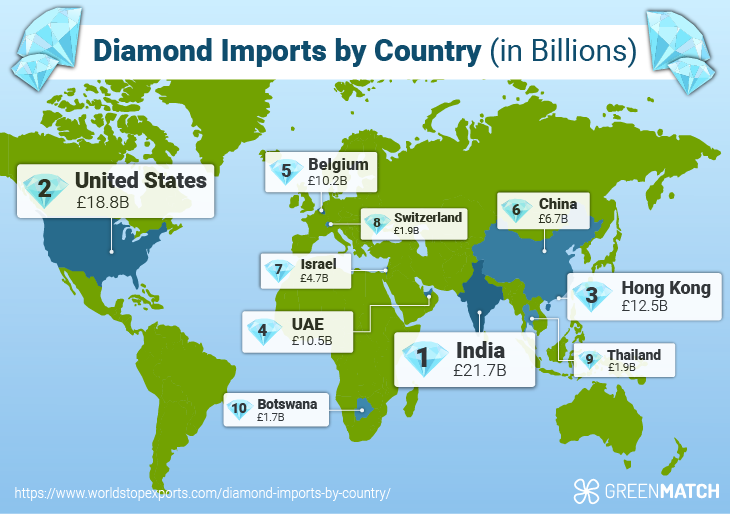
Diamond exports by country
Diamond sales were worth approximately £98.7 billion in 2022, with 5 major exporters including India, United States of America, United Arab Emirates, Hong Kong and Belgium.
Exports in value per country for the year 2022 are demonstrated below. These figures indicate the sheer value and volume of diamonds which pass between countries each year.
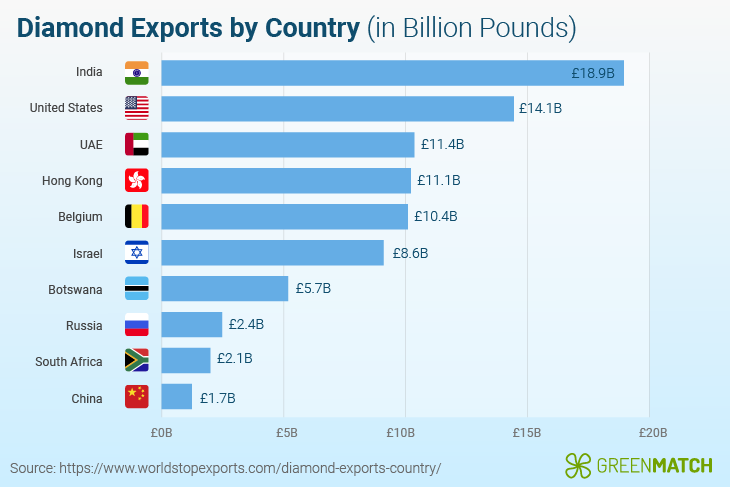
What are diamond alternatives?
With heightened awareness of the human and environmental impact of mined diamonds, alternative options in the form of lab-grown diamonds are now highly sought after.
Lab-grown diamonds, also known as lab-created or synthetic diamonds, are real diamonds created in a laboratory setting. Using processes that replicate the natural conditions under which diamonds form in the Earth's mantle, replica diamonds can be produced.
They have the same physical and chemical properties as natural diamonds and are visually identical. They are certified and graded for their qualities in the same way as mined diamonds and are available in different qualities, just like natural diamonds.
Lab-grown diamonds are popular for those looking for an environmentally friendly and socially ethical alternative to mined diamonds. These diamonds can also be up to 30% cheaper than natural diamonds.
Lab-grown diamonds are created using two main methods: High Pressure, High Temperature (HPHT) and Chemical Vapour Deposition (CVD). The HPHT method involves subjecting graphite to intense heat and pressure to create diamonds, while the CVD method uses moderate temperatures and lower pressure to grow diamonds. Both methods create real diamonds with the same characteristics as natural diamonds.
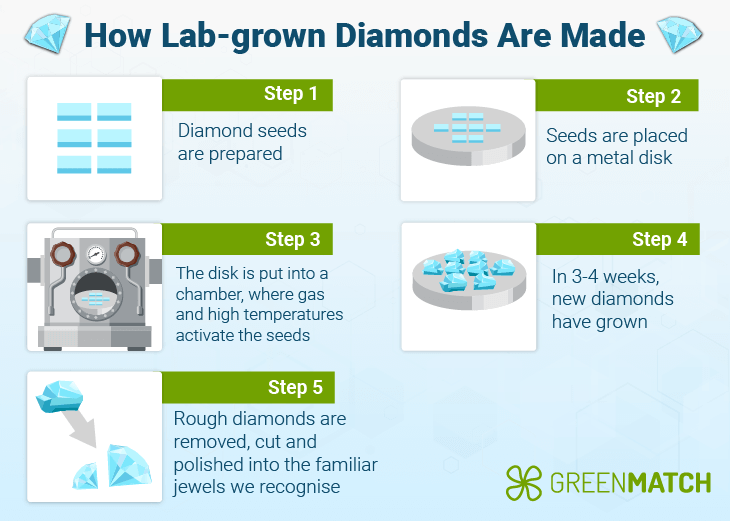
Other diamond alternatives include cubic zirconia and moissanite - which look similar to diamonds but share different chemical properties and usually sell for lower prices.
Environmental impact of lab-grown diamonds
Whilst diamond alternatives, grown in a lab, seem like the perfect solution to help avoid the ethical and environmental costs involved with mined diamonds, there are ongoing concerns about the true impact of synthetic diamonds.
Opting for lab-grown diamonds will avoid perpetuating the environmental harm diamond mining can create. [...] However, lab-grown diamonds have an environmental impact, too.
Some expert reports have concluded that lab-grown diamonds are a sustainable alternative, using up to seven times less water and emitting fewer greenhouse gases. They also avoid the negative impacts on ecosystems and wildlife associated with mining.
However, there are mixed opinions surrounding the creation of synthetic diamonds and whether the processes involved are more carbon-intensive overall.
Lab diamonds typically come from countries such as China and the US, which still rely heavily on fossil fuel energy. The amount of power needed to create diamonds is reported to release approximately three times the carbon emissions of mined diamonds.
There are mixed opinions on whether or not industry reports can be fully relied upon, however, as many aspects of diamond mining go unrecorded. Similarly, many new diamond labs based in the US operate on renewable energy, which experts say is not accounted for in some reports.
In a recent report by the jeweller Pandora, an analysis of the carbon footprint for three of their lab-grown diamond rings was undertaken. They concluded that production per ring contributed between 9 to 12 kg CO2e, with an average of '9.17 kg CO2e per grown, cut, and polished 1-carat lab-grown diamond'.
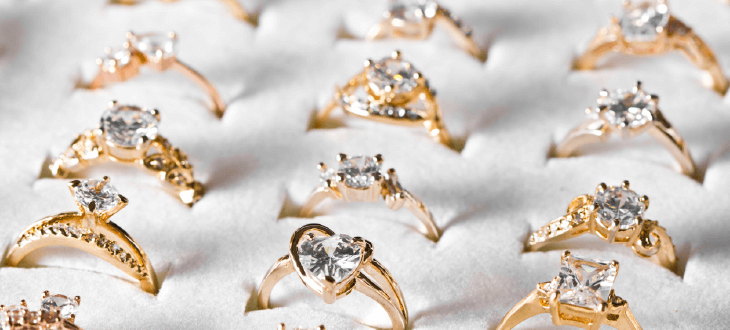
Pandora's analysis concluded that the most significant contributor to the product's carbon footprint was the production of the lab-grown diamond. They state:
Any improvements in the value chain should be directed toward diamond production. The synthesis process is the most energy-demanding part, even more extensive than the energy demanded by the cutting and polishing process (Sphera Solutions GmbH, 2020). It can also be noted that the cutting and polishing process is similar regardless of the origin of the diamonds.
Are diamonds sustainable?
Diamonds, whether mined or lab-grown, have environmental and social impacts.
Mined diamonds have been associated with land clearance, deforestation, habitat destruction, and human rights concerns. The energy and carbon emissions related to diamond mining are significant, and the industry has a history of ethical challenges.
On the other hand, lab-grown diamonds require less water; they do not harm ecosystems or displace wildlife. However, lab-grown diamond production also has environmental impacts, such as large energy consumption.
The sustainability of lab-grown diamonds is still a topic of debate, and more research and transparency are needed to make a definitive assessment. Ultimately, both options have pros and cons, and consumers are encouraged to make informed choices based on their values and priorities.
Is diamond production toxic?
Diamond production, both through mining and the creation of lab-grown diamonds, can have toxic and detrimental impacts on the environment and human health.
The negative effects of diamond mining include using toxic substances such as ferrosilicon (to separate diamonds from ore), hazardous chemicals, and the spread of diseases among labourers due to poor working conditions and sanitation.
While lab-grown diamonds may have a smaller immediate impact on ecosystems, the manufacturing process also involves energy consumption and potential chemical usage.
Diamond mining can involve various toxic chemicals and hazardous substances, posing environmental and human health risks. Some specific toxic chemicals associated with diamond mining include mercury, radon, diesel and explosives.
These chemicals and substances contribute to the overall environmental and health impacts of diamond mining, highlighting the importance of responsible and sustainable mining practices.
Can you recycle diamonds?
Diamonds cannot be recycled in the typical sense of the word - they cannot be transformed and reused as something else. They can, however, be reclaimed or repurposed, as they are highly resistant to damage and do not degrade naturally when used in jewellery, for example.
Jewellers may reuse diamonds in new pieces or restore old items for resale. Reusing diamonds or buying vintage pieces is a great way to avoid contributing to new environmental or ethical challenges associated with the mining industry.
Are diamonds biodegradable?
Diamonds do not naturally decompose or break down through biological processes. Diamonds are known for their exceptional durability and resistance to degradation.
Diamonds can degrade to graphite, but this process requires specific conditions and is extremely slow and virtually non-existent on a human time scale - meaning we can safely assume a diamond will outlast us!
If you are only going to wear a diamond on your finger at temperatures comfortable to humans away from high ion sources, then the diamond will last millions to billions of years. On a human time scale and for everyday human uses, the phrase "diamonds are forever" is a very good approximation to the reality.
The degradation of diamonds is not the same as the biodegrading of organic materials. Instead, it transforms from diamond to graphite, occurring over a long timescale.
Statistics, facts and figures about diamonds
The diamond industry encompasses a spectrum of data and statistics that provide insights into its global market trends, production, and ethical considerations. Here are some key statistics, facts, and figures related to diamonds:
-
The global diamond market value is estimated to be around £2 billion in 2024, growing from £1.9 billion in 2023. With a compound annual growth rate (CAGR) of 6.7%.
-
Russia, Botswana, and South Africa are among the top diamond-producing countries.
-
The UK's average spend on an engagement ring is between £1,400 and £2,400.
-
The average carat size of a diamond engagement ring in the UK is approximately 0.6 carats.
-
The most popular diamond shape for engagement rings is the round cut diamond, followed by the princess cut, cushion cut, and emerald cut diamonds.
-
The UK's most famous diamond colour rating is in the near-colourless range, specifically G, H, and I colour diamonds.
-
The global market size for lab-grown diamonds was valued at £17.3 billion in 2021 and is expected to expand at a CAGR of 8.55% during the forecast period, reaching approximately £28 billion by 2027.
-
Natural diamond companies have seen less competition from lab-grown diamonds in 2024, as their prices have fallen by more than 90% in just two years.
-
In the UK, lab-grown diamonds accounted for approximately 7-8% of the global diamond market in 2024.
-
On average, a £10,000 mined diamond could cost around £2,500 if it's lab-grown. The exact price difference varies based on size, quality, and type, but lab-grown diamonds are about 75% less expensive on average.
- De Beers is one of the world's most successful diamond mining companies. It has been dominant in the diamond industry since the 1880s. In 2020, its revenue hit £4.4 billion. They are responsible for the famous ad campaign that convinced consumers a diamond was the only proper way to proclaim your love - with the slogan 'A Diamond is Forever'.
Frequently asked questions about diamonds
No, diamonds which are mined typically cause devastating impacts on the environment and surrounding communities. Lab-grown diamonds may be a more sustainable choice, but more research is needed to determine this.
Diamond mining can negatively impact ecosystems and has a history of unethical treatment of workers. Lab-grown diamonds may be a more ethical and sustainable way to enjoy these gems.
Lab-grown diamonds are considered an ethical option, as they eliminate the social impact of mining, which includes harsh working conditions and poor treatment of mining communities.
Mining for diamonds typically involves the destruction of land and ecosystems, negatively impacting communities and presenting ethical challenges. Furthermore, the diamond trade can be used to fund civil wars.
Yes, lab-grown diamonds are an ethical alternative to mined diamonds, as they avoid the environmental and social impacts associated with mining operations.

Becky is an experienced SEO content writer specialising in sustainability and renewable trends. Her background in broadcast journalism inspires reliable content to help readers live more sustainably every day.
We strive to connect our customers with the right product and supplier. Would you like to be part of GreenMatch?

- What do we mean by diamond mining exactly?
- Environmental impact of diamonds
- Social impact of diamond mining
- Economic impact
- What are diamond alternatives?
- Are diamonds sustainable?
- Is diamond production toxic?
- Can you recycle diamonds?
- Are diamonds biodegradable?
- Statistics, facts and figures about diamonds
- Frequently asked questions


